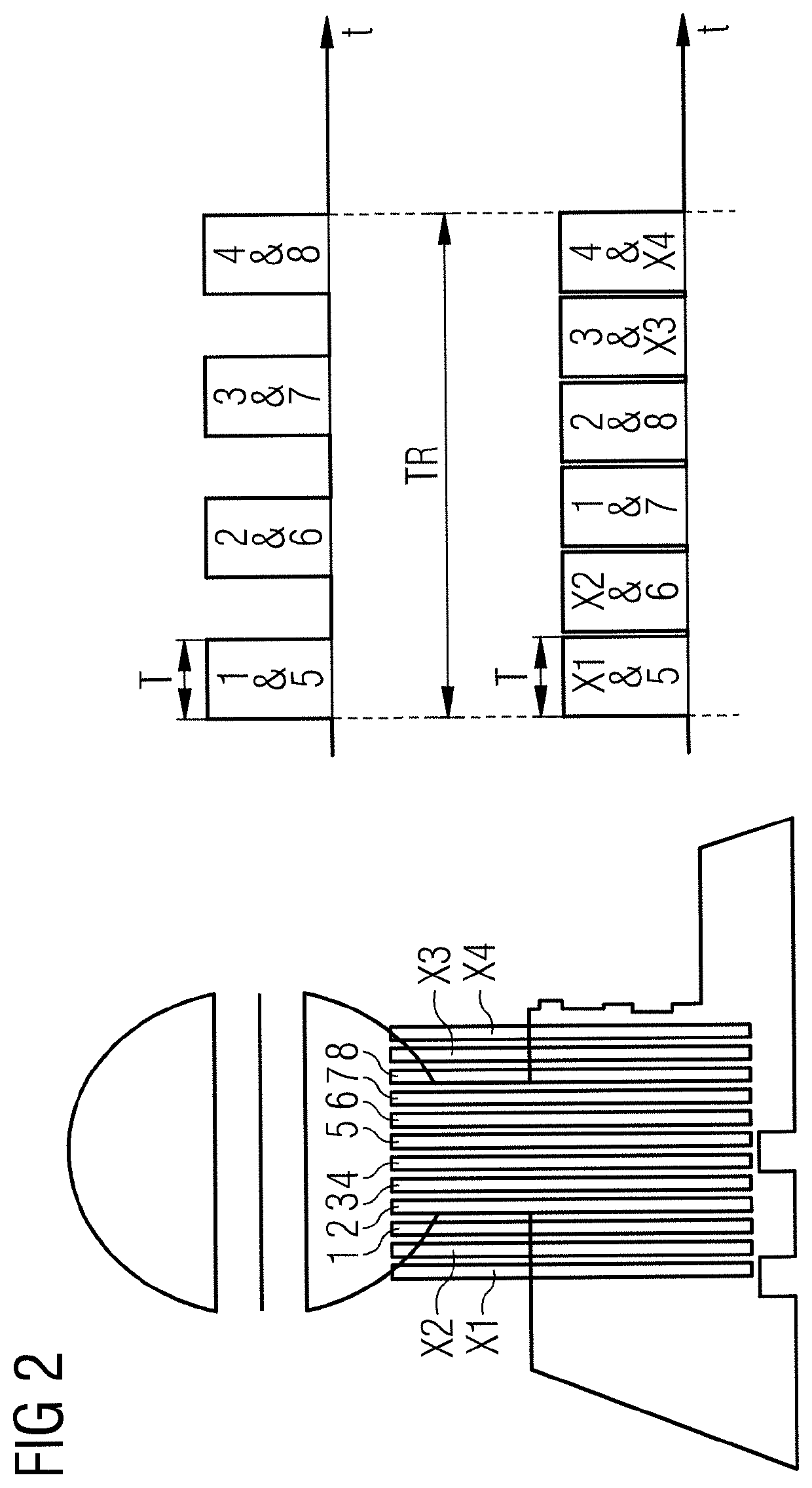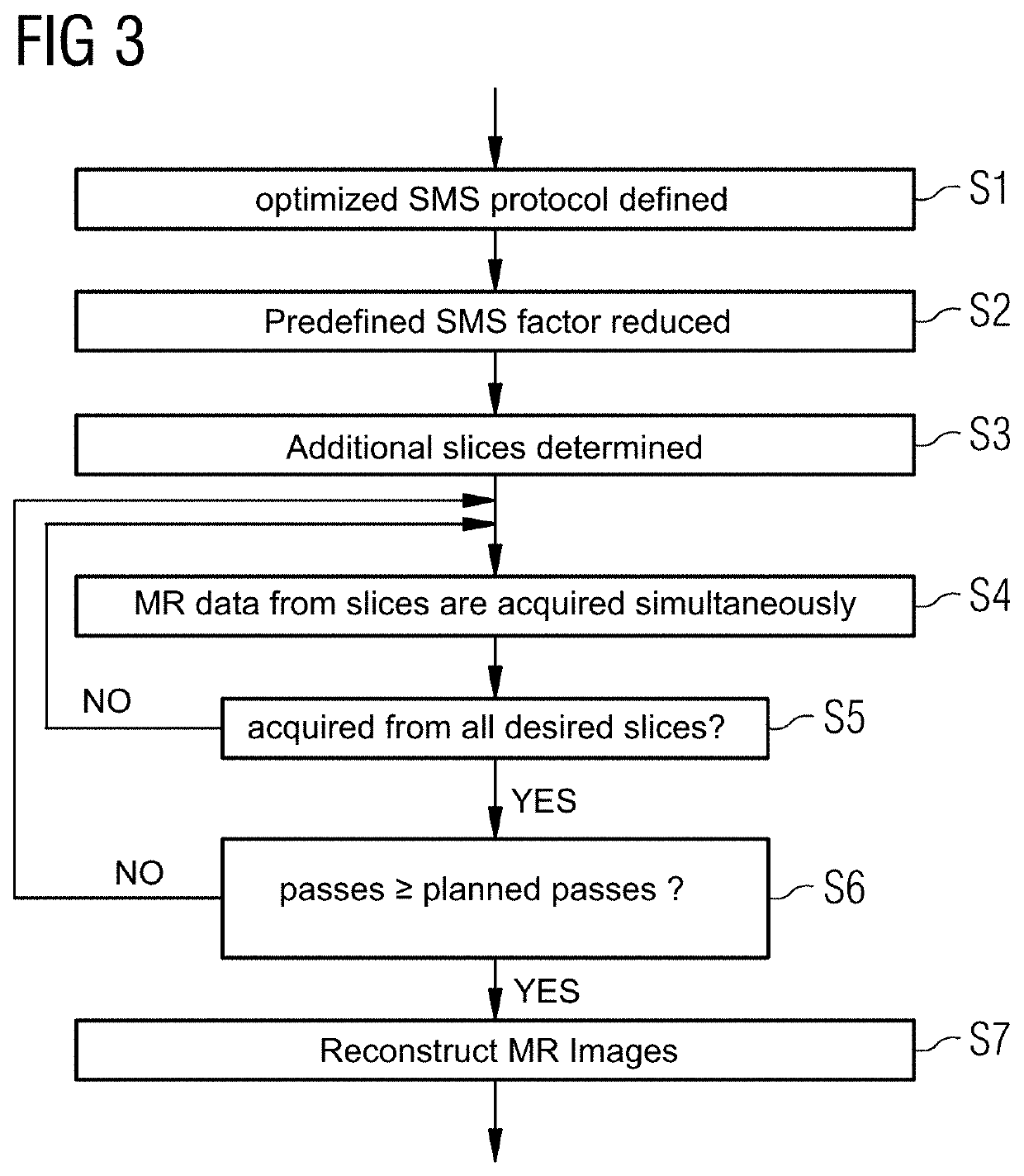Method and magnetic resonance apparatus for optimizing the simultaneous acquisition of magnetic resonance data from multiple slabs or slices
a technology of magnetic resonance data and optimizing simultaneous acquisition, applied in the direction of measuring using magnetic resonance, magnitude/direction of magnetic fields, instruments, etc., can solve the problems of insufficient representation of tissue with long t1 relaxation time, repetition time tr, etc., to increase the number of volume elements, facilitate signal separation, and increase the spatial separation of simultaneously excited volume elements
- Summary
- Abstract
- Description
- Claims
- Application Information
AI Technical Summary
Benefits of technology
Problems solved by technology
Method used
Image
Examples
example 1
[0077]Example 1 has the following requirements or conditions:[0078]The number of planned slices is 16, which is sufficient for a complete coverage of the volume portion to be examined.[0079]The desired contrast requires a minimum repetition time TR of 3200 ms.[0080]The duration of a single echo train (TSE module) and thus the scan time T is 250 ms.[0081]For a complete MR image, 20 echo trains are required.[0082]In order to achieve a sufficiently large signal-to-noise ratio, 5 averagings are needed.
[0083]In a conventional single-layer imaging process, a real repetition time TRreal=250 ms*16=4000 would result, from which the total scan time of 5*20*4000 ms=6:40 minutes results.
[0084]In a conventional multi-slice imaging process with an SMS factor of 2, the repetition time could be TR=250 ms*16 / 2=2000 ms. Since, however, the minimum repetition time TR is 3200 ms, the real repetition time corresponds to this predetermined minimum repetition time. On the basis of the small slice spacing ...
example 2
[0087]Example 2 has the following requirements or conditions:[0088]The number of planned slices is 10.[0089]The minimum repetition time TR is 2000 ms.[0090]The duration of a single echo train (TSE module) and thus the scan time T is 200 ms.[0091]For a complete MR image, 20 echo trains are required.[0092]2 is given as the SMS factor.
[0093]Since with the number of planned slices at 10, the repetition time TR of 2000 ms, the scan time T of 200 ms and the SMS factor of 2, the inequality (1) defined above is fulfilled, the SMS factor is decremented. Since the new or decremented SMS factor is 1, it need not be further checked whether the inequality (1) also applies for the new SMS factor. Rather, the 10 planned slices are acquired conventionally, i.e. with a single slice imaging process. By this means, additional noise (“g-factor noise”) and deconvolution artifacts are prevented.
example 3
[0094]Example 3 has the following requirements or conditions:[0095]The number of planned slices is 12.[0096]The minimum repetition time TR is 2800 ms.[0097]The duration of a single echo train (TSE module) and thus the scan time T is 400 ms.[0098]3 is given as the SMS factor.
[0099]Since with the number of planned slices at 12, the repetition time TR of 2800 ms, the scan time T of 400 ms and the SMS factor of 3, the inequality (1) defined above is fulfilled, the SMS factor is decremented. Since the above inequality (1) for the new SMS factor 2 no longer applies, the MR data is acquired with the SMS factor 2. Since the number of all slices according to equation (3) is 14, in addition to the 12 planned slices, 2 additional slices are acquired.
[0100]FIG. 3 shows a flowchart for the inventive method.
[0101]In step S1, the user defines for his requirements (contrast and slice coverage) an optimized SMS protocol in that the number of planned slices, the repetition time TR, the scan time T an...
PUM
 Login to View More
Login to View More Abstract
Description
Claims
Application Information
 Login to View More
Login to View More - R&D
- Intellectual Property
- Life Sciences
- Materials
- Tech Scout
- Unparalleled Data Quality
- Higher Quality Content
- 60% Fewer Hallucinations
Browse by: Latest US Patents, China's latest patents, Technical Efficacy Thesaurus, Application Domain, Technology Topic, Popular Technical Reports.
© 2025 PatSnap. All rights reserved.Legal|Privacy policy|Modern Slavery Act Transparency Statement|Sitemap|About US| Contact US: help@patsnap.com



